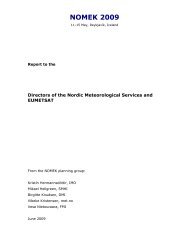International Symposium on Mitigative Measures against Snow ...
International Symposium on Mitigative Measures against Snow ...
International Symposium on Mitigative Measures against Snow ...
Create successful ePaper yourself
Turn your PDF publications into a flip-book with our unique Google optimized e-Paper software.
<str<strong>on</strong>g>Internati<strong>on</strong>al</str<strong>on</strong>g> <str<strong>on</strong>g>Symposium</str<strong>on</strong>g> <strong>on</strong> <strong>Mitigative</strong> <strong>Measures</strong> <strong>against</strong> <strong>Snow</strong> Avalanches<br />
Egilsstaðir, Iceland, March 11–14, 2008<br />
gas. For example, the Gazex® uses an oxygen-propane mixture, heavier than the air that<br />
remains at the base of the pipe during injecti<strong>on</strong>.<br />
Figure 1 Gazex® system<br />
2. DAISY BELL®: PRINCIPLE OF OPERATION<br />
Daisy Bell® project is born from a desire for a gas system movable and operable, hung under<br />
a helicopter. The Avalhex® and Avalanche Blast® systems, which are already movable, use a<br />
latex ballo<strong>on</strong> to c<strong>on</strong>fine the gas mixture. They are very useful to treat avalanches but they<br />
raise technical difficulties. Indeed, precise and complex mechanisms are necessary to c<strong>on</strong>nect<br />
gas reserves to the ballo<strong>on</strong> to be pumped up and then to the next <strong>on</strong>e. They are hardly<br />
compatible with use c<strong>on</strong>diti<strong>on</strong>s (cold, frost…) and pose mechanical problems. Moreover,<br />
using ballo<strong>on</strong>s raises aut<strong>on</strong>omy problems and these systems enable finally <strong>on</strong>ly a limited<br />
number of avalanche releases.<br />
All these observati<strong>on</strong>s have led to the development of Daisy Bell® with an initial idea: to<br />
replace the ballo<strong>on</strong> temporary volume by a permanent metal <strong>on</strong>e. At the beginning of the<br />
development, a flap system was foreseen to be closed during the gas injecti<strong>on</strong> and opened just<br />
before the igniti<strong>on</strong>. Using an oxygen-hydrogen mixture was the sec<strong>on</strong>d basic idea. This<br />
mixture is lighter than the air, so a system directed towards the bottom can be designed.<br />
Moreover, the explosi<strong>on</strong> of an oxygen-hydrogen stoechiometric mixture is explosive and<br />
releases maximum energy, so it is very interesting for an artificial avalanche release.<br />
After that, different types of bells have been tested, first being hung to a crane. These first<br />
experiments had many goals:<br />
• Choose the best shape and check its compatibility with the initial c<strong>on</strong>tainment of<br />
the gas mixture injected from the top<br />
• Check the ability to make a det<strong>on</strong>ati<strong>on</strong><br />
• Sort the explosi<strong>on</strong> c<strong>on</strong>sequences according to the mixture parameters: proporti<strong>on</strong>,<br />
volume.<br />
These c<strong>on</strong>sequences of an explosi<strong>on</strong> must ensure a compromise between the efficiency of the<br />
wave directed towards the ground and the reacti<strong>on</strong> <strong>on</strong> the system and c<strong>on</strong>sequently <strong>on</strong> the<br />
helicopter. Indeed, the explosi<strong>on</strong> causes a reacti<strong>on</strong> <strong>on</strong> the volume to the top, which then falls<br />
92 A new helicopter gas device for avalanche preventive release











